You have a Fabric workspace that contains a warehouse named Warehouse!. Warehousel contains a table named DimCustomers. DimCustomers contains the following columns:
• CustomerName
• CustomerlD
• BirthDate
• Email
You need to configure security to meet the following requirements:
• BirthDate in DimCustomer must be masked and display 1900-01-01.
• Email in DimCustomer must be masked and display only the first leading character and the last five characters.
How should you complete the statement? To answer, select the appropriate options in the answer area. NOTE: Each correct selection is worth one point.

HOTSPOT
You have a Fabric workspace that contains an eventstream named EventStream1.
You discover that an EventStream1 transformation fails.
You need to find the following error information:
The error details, including the occurrence time
The total number of errors
What should you use? To answer, select the appropriate options in the answer area.
NOTE: Each correct selection is worth one point.
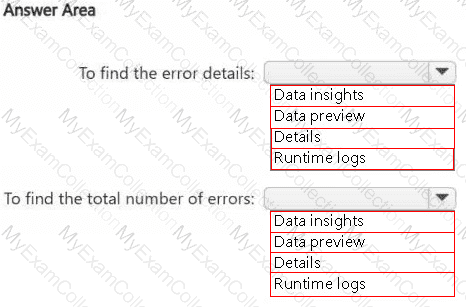
You have a Fabric workspace that contains a Real-Time Intelligence solution and an eventhouse.
Users report that from OneLake file explorer, they cannot see the data from the eventhouse.
You enable OneLake availability for the eventhouse.
What will be copied to OneLake?
You have a Fabric workspace named Workspace1.
You plan to configure Git integration for Workspace1 by using an Azure DevOps Git repository. An Azure DevOps admin creates the required artifacts to support the integration of Workspace1 Which details do you require to perform the integration?
Note: This question is part of a series of questions that present the same scenario. Each question in the series contains a unique solution that might meet the stated goals. Some question sets might have more than one correct solution, while others might not have a correct solution.
After you answer a question in this section, you will NOT be able to return to it. As a result, these questions will not appear in the review screen.
You have a Fabric eventstream that loads data into a table named Bike_Location in a KQL database. The table contains the following columns:
BikepointID
Street
Neighbourhood
No_Bikes
No_Empty_Docks
Timestamp
You need to apply transformation and filter logic to prepare the data for consumption. The solution must return data for a neighbourhood named Sands End when No_Bikes is at least 15. The results must be ordered by No_Bikes in ascending order.
Solution: You use the following code segment:

Does this meet the goal?
You need to recommend a solution to resolve the MAR1 connectivity issues. The solution must minimize development effort. What should you recommend?
You need to ensure that the data analysts can access the gold layer lakehouse.
What should you do?
You need to ensure that WorkspaceA can be configured for source control. Which two actions should you perform?
Each correct answer presents part of the solution. NOTE: Each correct selection is worth one point.
You need to recommend a method to populate the POS1 data to the lakehouse medallion layers.
What should you recommend for each layer? To answer, select the appropriate options in the answer area.
NOTE: Each correct selection is worth one point.
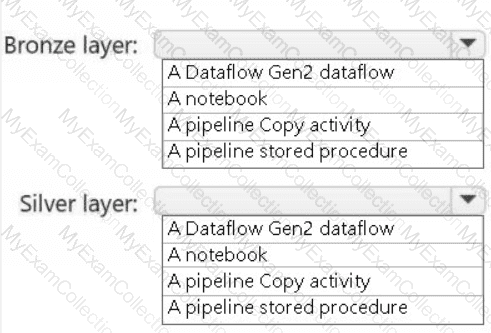
You need to ensure that the authors can see only their respective sales data.
How should you complete the statement? To answer, drag the appropriate values the correct targets. Each value may be used once, more than once, or not at all. You may need to drag the split bar between panes or scroll to view content
NOTE: Each correct selection is worth one point.
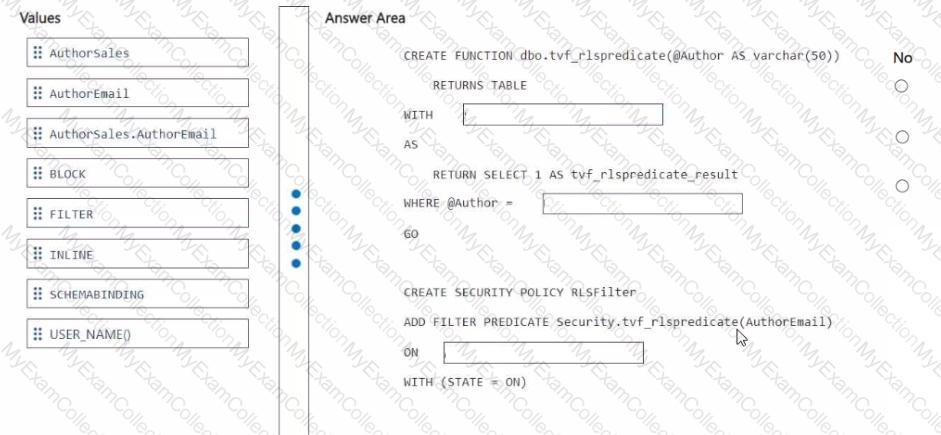
You need to ensure that the data engineers are notified if any step in populating the lakehouses fails. The solution must meet the technical requirements and minimize development effort.
What should you use? To answer, select the appropriate options in the answer area.
NOTE: Each correct selection is worth one point.

You need to populate the MAR1 data in the bronze layer.
Which two types of activities should you include in the pipeline? Each correct answer presents part of the solution.
NOTE: Each correct selection is worth one point.
You need to implement the solution for the book reviews.
Which should you do?
HOTSPOT
You need to troubleshoot the ad-hoc query issue.
How should you complete the statement? To answer, select the appropriate options in the answer area.
NOTE: Each correct selection is worth one point.
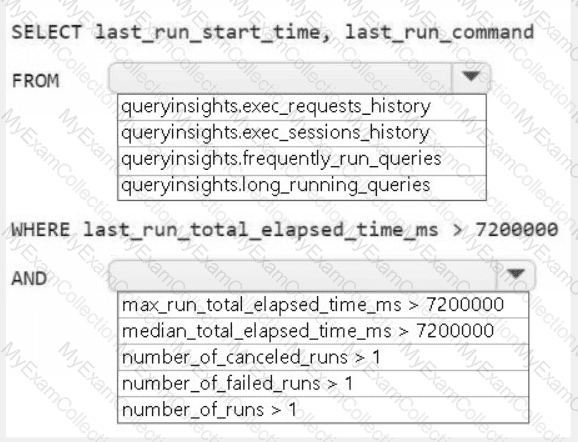
What should you do to optimize the query experience for the business users?
You need to resolve the sales data issue. The solution must minimize the amount of data transferred.
What should you do?
You have an Azure key vault named KeyVaultl that contains secrets.
You have a Fabric workspace named Workspace!. Workspace! contains a notebook named Notebookl that performs the following tasks:
• Loads stage data to the target tables in a lakehouse
• Triggers the refresh of a semantic model
You plan to add functionality to Notebookl that will use the Fabric API to monitor the semantic model refreshes. You need to retrieve the registered application ID and secret from KeyVaultl to generate the authentication token. Solution: You use the following code segment:
Use notebookutils. credentials.getSecret and specify key vault URL and the name of a linked service.
Does this meet the goal?
Note: This question is part of a series of questions that present the same scenario. Each question in the series contains a unique solution that might meet the stated goals. Some question sets might have more than one correct solution, while others might not have a correct solution.
After you answer a question in this section, you will NOT be able to return to it. As a result, these questions will not appear in the review screen.
You have a KQL database that contains two tables named Stream and Reference. Stream contains streaming data in the following format.
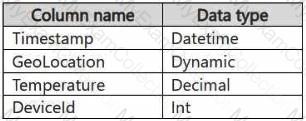
Reference contains reference data in the following format.

Both tables contain millions of rows.
You have the following KQL queryset.

You need to reduce how long it takes to run the KQL queryset.
Solution: You move the filter to line 02.
Does this meet the goal?
You have a Google Cloud Storage (GCS) container named storage1 that contains the files shown in the following table.

You have a Fabric workspace named Workspace1 that has the cache for shortcuts enabled. Workspace1 contains a lakehouse named Lakehouse1. Lakehouse1 has the shortcuts shown in the following table.

You need to read data from all the shortcuts.
Which shortcuts will retrieve data from the cache?



 A screenshot of a computer Description automatically generated
A screenshot of a computer Description automatically generated


 A screenshot of a computer Description automatically generated
A screenshot of a computer Description automatically generated
